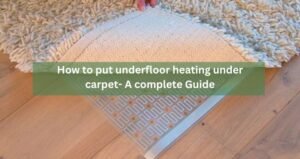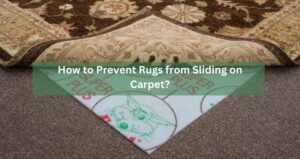When it comes to enhancing the comfort, durability, and aesthetic appeal of your stairs, selecting the right carpet padding is just as important as choosing the carpet itself. While often overlooked, Stair Carpets padding plays a significant role in ensuring a pleasant walking experience, minimizing wear and tear, and improving the longevity of your carpet. With so many options available, it can be overwhelming to choose the best padding for your stairs. This blog post will guide you through the process of selecting the right stair carpet padding to ensure comfort, safety, and style.
Why Carpet Padding is Important for Stairs
Carpet padding, also known as underlayment or cushioning, is the material placed between the carpet and the subfloor. It serves as the foundation for your carpet and offers several benefits:
- Comfort: Padding provides a soft and cushioned feel underfoot, making it more comfortable to walk, stand, or sit on your stairs.
- Durability: Quality padding helps to extend the life of your carpet by absorbing impact and reducing wear from foot traffic.
- Noise Reduction: It minimizes the noise from footsteps, offering a quieter, more peaceful home environment, especially in multi-level homes.
- Safety: Padding helps reduce the risk of slips and falls by providing a stable surface.
- Insulation: It adds an extra layer of thermal insulation, keeping your home warmer in the winter and cooler in the summer.
Factors to Consider When Choosing Stair Carpet Padding
When selecting the ideal padding for your stairs, several key factors should influence your decision. You should consider these factors well before booking a Carpet Installation Service. Let’s dive deeper into each aspect to help you make an informed choice.
1. Material Type
The material of the carpet padding directly impacts its performance and longevity. Common materials include:
- Foam: One of the most popular choices for carpet padding, foam is lightweight, comfortable, and affordable. It works well for most carpet types and is especially effective in areas with moderate foot traffic. However, foam may compress over time and lose its supportive qualities, so it may not be ideal for high-traffic stairs.
- Rubber: Rubber padding is known for its durability and resilience. It provides excellent support and comfort underfoot while absorbing sound effectively. Rubber is also resistant to mold and mildew, making it a good choice for areas with higher humidity. It’s perfect for high-traffic areas and is highly recommended for staircases.
- Felt: Felt padding offers a firm foundation and is great for high-traffic areas. It’s often made from recycled materials, making it an eco-friendly option. Felt padding may be firmer than foam but is ideal for durability and performance in areas like stairs.
2. Thickness
Thickness is one of the most important considerations when selecting stair carpet padding. However, thicker padding isn’t always better, especially for stairs. Here’s why:
- Too Thick: If the padding is too thick, it can make your stairs feel squishy or unstable. Excessive padding might also cause the carpet to shift or wrinkle, leading to an unsafe walking surface.
- Too Thin: On the other hand, if the padding is too thin, it won’t provide the necessary cushioning or support, which can lead to a hard, uncomfortable surface and premature carpet wear.
3. Density
The density of the padding refers to how compact or tightly packed the material is. A denser padding provides better cushioning and support, making it ideal for high-traffic areas like stairs. Higher density padding resists wear, maintains its shape over time, and improves the overall durability of your carpet.
Low-density padding, while cheaper, may not withstand the weight of heavy foot traffic, leading to quick compression and a loss of support. Look for padding with a density rating that’s appropriate for your stairs—generally, a higher density is better for staircases, especially those that experience frequent use.
4. Resilience
Resilience is a measure of how well the padding springs back to its original shape after pressure is applied. A high resilience padding retains its shape longer, ensuring that your carpet stays plush and supportive for a longer period of time. This is particularly important for stairs, where the padding will need to support weight and pressure from foot traffic on a consistent basis.
5. Moisture Resistance
Stairs can be an area susceptible to moisture, especially in homes with children or pets, or if your stairs are located near entryways where rain or snow may be tracked in. Choosing a padding that is resistant to moisture can help prevent mold and mildew buildup, which can damage both your carpet and the padding itself.
6. Noise Reduction
Stairways are often one of the noisiest parts of a home, especially when you have children, pets, or guests coming up and down. A good carpet padding can help absorb sound, reducing noise and creating a more peaceful living environment.
7. Cost vs. Quality
While it’s tempting to choose the cheapest Carpets Dubai, it’s important to remember that padding is an investment in the comfort and durability of your stairs. Opting for low-quality padding may save money upfront but could cost you more in the long run, as you’ll need to replace it sooner or deal with discomfort, wear, and noise.
Types of Stair Carpet Padding to Consider
Now that we’ve discussed the key factors to consider, here are some popular types of carpet padding ideal for stairs:
- High-Density Foam Padding: Great for comfort and affordability, ideal for medium-traffic areas.
- Rubber Padding: Perfect for high-traffic areas and stairs, offering excellent durability and noise reduction.
- Felt Padding: A sturdy and eco-friendly option that offers firm support, great for high-traffic stairs.
- Urethane Foam Padding: A well-rounded option with a balance of comfort and durability.
Conclusion
Choosing the right carpet padding for your stairs is crucial to ensure comfort, longevity, and safety. While there are many factors to consider, such as material, thickness, density, and moisture resistance, it’s essential to choose a padding that suits your specific needs and preferences. Rubber and high-density foam are great choices for most staircases, providing a balance of support, comfort, and durability.






